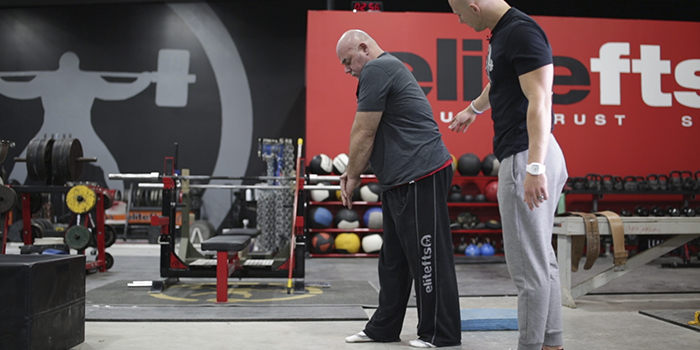
Editor's Note: Fixing Dave Tate is an educational video series intended for demonstration purposes only (acts as a case study specific to Dave Tate). It is not intended to medically diagnose, treat, or manage symptoms. If you are in pain, please consult a licensed healthcare professional.
At this stage in the process, Dr. Rusin and Dave have already completed an analysis of Dave's subjective history and a comprehensive movement screen. Now, in this third video, Dr. Rusin performs and orthopedic evaluation of Dave. Whereas the previous screen was intended to identify red flags, this assessment will consist of clinically-based testing to produce both a medical diagnosis and a functional movement capacity diagnosis. Dr. Rusin begins by explaining that this evaluation starts with a top-down approach with global movements, assessing pain provocation (is this painful for Dave or not) and whether the movement pattern is functional or dysfunctional. Through this evaluation, Dr. Rusin will isolate key areas to know where to improve.
Toe Touch Test
Dr. Rusin Begins by looking at the pillar complex of the spine, including flexion and extension. For his first test he has Dave stand with his feet together, knees locked, and his arms extended forward, hand over hand. Dave then moves downward to reach toward the floor. In this test, Rusin looks at spinal curvature and posterior hip shift. In assessing Dave, he sees that Dave's back stays very flat with minimal flexion and his pelvis demonstrates inability to "unlock" and rotate optimally. Dr. Rusin also explains why this is likely not a result of Dave's hip replacements.
Asymmetrical Stance Toe Touch
This is similar to the previous movement, but with an offset stance: left foot forward with right foot back, majority of weight on left side. Then Dave must reach toward the floor in the same manner as the normal toe touch. In the asymmetrical stance, Dr. Rusin notes more lumbar flexion, better posterior hip translation, and a small amount of pelvic rotation beginning to occur. Alternating Dave's stance so the right foot is forward instead of the left, Dr. Rusin observes similar improvement over the basic toe touch.
Dr. Rusin then moves Dave to the table to remove the motor control component from testing. The purpose of having Dave lie on his back is to enable evaluation of his body in a motor control independent position. This will show how the joints and soft tissues are able to move without restriction of motor control.
Passive Versus Active Straight Leg Raise
From a supine position, Dave does a straight leg raise, followed by Dr. Rusin pushing his leg even further once Dave reaches the top end of his range of motion. By comparing the passive versus active range of motion, Dr. Rusin is able to identify the motor control gap, which is the passive range of motion minus the active range of motion. If the difference is more than about 10%, it exposes an athlete to injury.
Dr. Rusin then moves Dave through a number of passive range of motion tests, including internal and external hip rotation. These both test very well, which is to be expected given Dave's replaced hips. He notes that Dave demonstrates great mobility while lying passive on the table, despite his remarkable immobility while standing. After further testing on external rotation and adduction and abduction, Dr. Rusin then has Dave lie on his stomach to evaluate rotation and extension. From a hip neutral position, Dr. Rusin guides Dave through internal and external rotation and observes compensation similar to what was visible in the supine position. Then with Dave in a 90-degree knee bend position, he has him lift his heel toward the ceiling and notes Dave's acceptable hip extension.
Multisegmental Extension, Passive Extension Testing, and Hip Flexor Mobility
Back in a standing position, Dr. Rusin has Dave stand with his feet together and reach toward the ceiling, extending his body upward as much as he can. Rusin notes that Dave's pelvis translates anteriorly in this position better than it did posteriorly in previous tests. There are also multiple places that Dave fails to reach extension while in this position. Dr. Rusin then tests Dave again, this time in a passive position on his stomach, through a prone press-up extension. One component of this test is the hip flexors' mobility to keep the front of the pelvis within two to three inches of the table.
Based on the results of this test, Dr. Rusin moves Dave into a hip flexor testing position. What he looks for, through a Thomas test position, is the ability of the knee to move past the neutral line of the hip without rotation. Dave shows decent mobility but limitations on the front side of the quadriceps, namely the rectus femoris. Using the Ober's test position (side-lying with shoulder over shoulder and knee over knee), Dr. Rusin also tests the lateral hip group and sees that Dave's body fights full excursion into extension plus adduction; his body immediately tightens up to stay out of that position.
Rotation Testing
The final lower body test Dr. Rusin does on Dave is global standing rotation. With feet together, Dave attempts to rotate back as far as he can. The goal is 100 total degrees from the hips plus the thoracic spine and the shoulders, which Dave doesn't achieve. By moving Dave into a seated rotation testing position and then a quadruped position, Dr. Rusin further evaluates the thoracic spine and cervical spine. Through both active and passive testing, he sees that Dave has substantial excess capacity in passive range of motion than passive range of motion in thoracic spine rotation, again indicating a large motor control gap.
Upper Quadrant Testing
Shifting gears to the upper quadrant of Dave's body, Dr. Rusin begins by looking at the shoulders and the neck in flexion, extension, and rotation. Keeping Dave's body in a neutral position he has him perform various movements and observes right side spinal rotation deficiency, right side bend deficiency, and right side upper cervical flexion deficiency.
Shoulder Range of Motion Assessment
To test his shoulder range of motion, Dr. Rusin has Dave lie on his back and raise his shoulders over his head. This reveals tremendous range of motion in his left shoulder but very limited range in his right shoulder. Further, he shows greater range of motion when performing the movement unilaterally. Testing internal rotation, external rotation, and elevation also reveals severe limitations in each of them. Through arm raising tests in both Y-style movements and side raising, Dr. Rusin tests the ability of the scapula and lats to stabilize and control movement. With this testing, Dr. Rusin explains that moving forward in this process, mobilizing Dave's thoracic spine and being able to reintegrate the scapula will be key.
Balance Assessment
The very final part of this orthopedic evaluation is assessing Dave's balance. The goal here is to see where Dave's balance is weakest and what body control he can exhibit. There are three compensation patterns that can arise here: ankle and foot stability, hip stability, and torso stability. The first test puts Dave in a one-leg standing test, holding the other at a 90-degree angle in front of him. Dr. Rusin sees opposite compensation patterns from the left to the right side. Repeating the test with his eyes closed, Dave compensates with his torso and fails to remain standing.
Moving to a kneeling position, Dave shows no struggle maintaining balance with his eyes open. With his eyes closed, he begins to lean laterally, especially with his right leg forward. Dr. Rusin then has Dave repeat the test with a narrower base, with his front heel directly in front of his back knee. In each of these tests, Dave demonstrates greater stability with his right leg forward than his left.
By the minute:
- (2:30) Toe touch test
- (6:00) Asymmetrical stance toe touch
- (8:33) Moving to a supine position
- (9:16) Passive vs. active straight leg raise
- (12:21) Rotation and hip extension
- (17:37) Multisegmental extension and passive extension
- (22:50) Hip flexor testing
- (27:35) Global standing rotation and seated thoracic spine testing
- (31:16) Upper quadrant testing
- (33:56) Shoulder range of motion testing
- (48:02) Balance assessment
FIXING DAVE TATE SERIES
- Initial Assessment with Dr. John Rusin
- Movement Screening
- Orthopedic Evaluation
- The Three Areas of Focus Discovered During Initial Evaluation
- Observing Dave's Current Training Capabilities
- Programming the Six-Phase Dynamic Warm-up Sequence
- The Dynamic Warm-Up Sequences for Upper Body and Lower Body










1 Comment